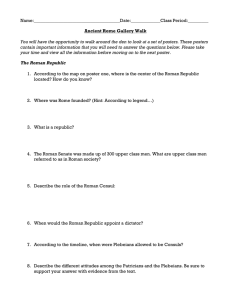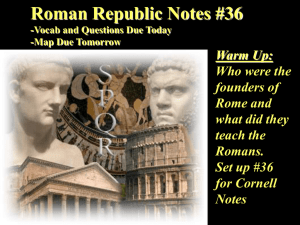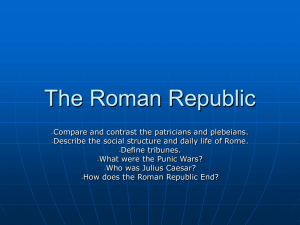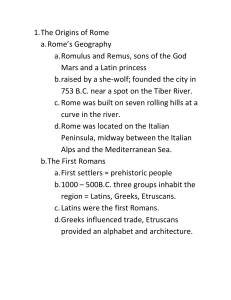The Early Roman Republic
advertisement
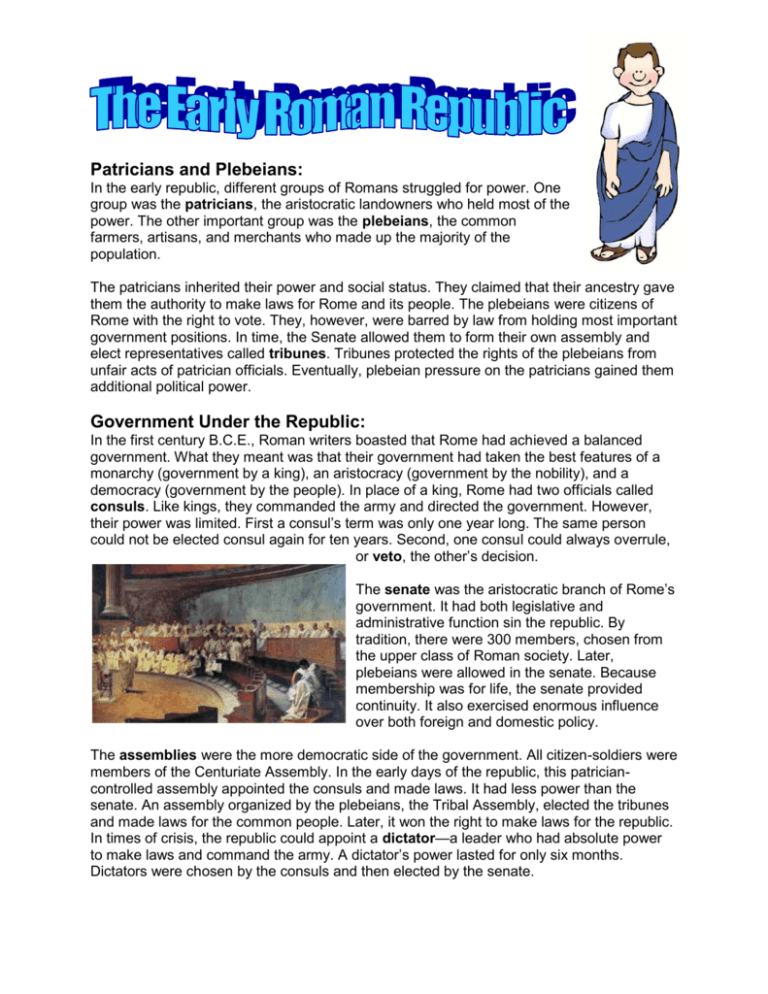
Patricians and Plebeians: In the early republic, different groups of Romans struggled for power. One group was the patricians, the aristocratic landowners who held most of the power. The other important group was the plebeians, the common farmers, artisans, and merchants who made up the majority of the population. The patricians inherited their power and social status. They claimed that their ancestry gave them the authority to make laws for Rome and its people. The plebeians were citizens of Rome with the right to vote. They, however, were barred by law from holding most important government positions. In time, the Senate allowed them to form their own assembly and elect representatives called tribunes. Tribunes protected the rights of the plebeians from unfair acts of patrician officials. Eventually, plebeian pressure on the patricians gained them additional political power. Government Under the Republic: In the first century B.C.E., Roman writers boasted that Rome had achieved a balanced government. What they meant was that their government had taken the best features of a monarchy (government by a king), an aristocracy (government by the nobility), and a democracy (government by the people). In place of a king, Rome had two officials called consuls. Like kings, they commanded the army and directed the government. However, their power was limited. First a consul’s term was only one year long. The same person could not be elected consul again for ten years. Second, one consul could always overrule, or veto, the other’s decision. The senate was the aristocratic branch of Rome’s government. It had both legislative and administrative function sin the republic. By tradition, there were 300 members, chosen from the upper class of Roman society. Later, plebeians were allowed in the senate. Because membership was for life, the senate provided continuity. It also exercised enormous influence over both foreign and domestic policy. The assemblies were the more democratic side of the government. All citizen-soldiers were members of the Centuriate Assembly. In the early days of the republic, this patriciancontrolled assembly appointed the consuls and made laws. It had less power than the senate. An assembly organized by the plebeians, the Tribal Assembly, elected the tribunes and made laws for the common people. Later, it won the right to make laws for the republic. In times of crisis, the republic could appoint a dictator—a leader who had absolute power to make laws and command the army. A dictator’s power lasted for only six months. Dictators were chosen by the consuls and then elected by the senate. The Roman Army: All citizens who owned land were required to serve in the army. To secure certain public offices, ten years of military service were required. Roman soldiers were organized into large military units called legions. The Roman legion was made up of some 5,000 heavily armed foot soldiers (infantry). A group of soldiers on horseback (cavalry) supported each legion. Legions were divided into smaller groups of 80 men, each of which was called a century. The centurian was the Roman officer in charge of a century. In battle, the strength of the legion was its flexibility. Each century in a legion could act independently. The military organization and fighting skill of the Roman army were key factors in Rome’s rise to greatness. Roman Citizenship: In the time of the Republic, the rights of citizenship could be acquired by birth, by naturalization [by petitioning for citizenship of foreign-born], or for a slave, by being freed by his master. Children of a legal marriage enjoyed these rights. Before 445 B.C.E., a legal marriage could be entered into by patricians only, but in that year it was given to plebeians also. Foreigners could gain the rights of Roman citizenship only through the action of the Popular Assembly. The formal announcement of a slave’s freedom by his master made him a citizen. The slaves of a Latin acquired the rights of citizenship when he was adopted by a Roman citizen. [Latins were members of one of the tribes on the peninsula of Italy]. Under the Roman Empire, the practices of the Republic continued and others were added. Those who received an honorable discharge after having served 25 years in the auxiliary force, or 26 years in the navy, became Roman citizens. Latins gained the same privilege when they were enrolled in the Roman legions, and magistrates in the towns enjoying the Latin rights were honored with Roman citizenship. Freedmen also, after serving a certain number of years as "sentinels’ gained full civic rights. The conditions on which citizenship was granted to individuals or particular communities cannot be so exactly stated. Personal favor, or political considerations, or a desire to reward those who had rendered a noteworthy service to the community were usually the deciding factors in these cases. The greatest addition to the number of citizens, however, came by way of freeing the slaves. All Roman citizens, except freedmen, had the full employment of the traditional rights of commerce, marriage, the right of appeal, the right to due process of law; the right to vote, and the right to hold office. The two principal obligations resting on Roman citizens were the payment of taxes and service in the army. Roman citizens in Italy paid no direct taxes. Those in the provinces were subject to two taxes. The exemption of Roman citizens in Italy was the peculiar privilege going with the Italic Rights. Military service was incumbent on [necessary for] every freeman but, since a sufficient number of soldiers were usually to be had by voluntary enlistment, it was rarely necessary to resort to a draft. In fact, after the time of the Flavian emperors, the Roman Legions were never recruited from Italy. The legions and the Praetorian Guard were made up exclusively of free-born Roman citizens and of Latins. Freedmen served in the navy. 1. Identify the key differences between the plebeians and the patricians? Plebeians Patricians 2. Identify the key responsibilities of the following components of Roman government. Consuls Senate Assembly Dictator 3. Create a chart that outlines the chain of command of the Roman military: 4. How did an individual become a citizen of Rome? 5. What rights did a Roman citizen retain?
